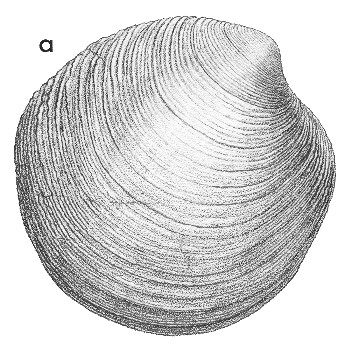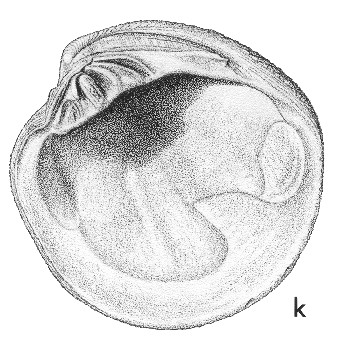
Revised descriptions of New Zealand Cenozoic Mollusca from Beu and Maxwell (1990)

 | Revised descriptions of New Zealand Cenozoic Mollusca from Beu and Maxwell (1990) | 
|
  (Pl. 19a): GS9866, M34/f9146, "Neothyris shellbed", Weka Creek, North Canterbury, Altonian (GNS) |
  (Pl. 19k): GS9866, M34/f9146, "Neothyris shellbed", Weka Creek, North Canterbury, Altonian (GNS) |
Beu & Maxwell (1990): Chapter 11; p. 187; pl. 19 a,k.
Synonymy: Dosinia (Raina) bensoni Marwick 1927, p. 587
Type species of Raina Marwick, 1927
Classification: Veneridae: Dosiniinae
Description: Moderately large for genus (length 65-85 mm), robust, moderately inflated; posterior area slightly flattened. Lunule relatively long, impressed or weakly pouting; escutcheon more prominent in left than in right valve. Commarginal sculpture on posterior area and towards anterior end of thin, lamellar ridges; central area somewhat polished on well preserved shells, sculpture reduced to shallow grooves with relatively broad, smooth interspaces, more numerous and more closely spaced near ventral margin. Ridges decreasing abruptly in strength on left escutcheon, but continuing virtually unchanged across right escutcheon. Left hinge with a prominent, rugose anterior lateral tooth, a thin anterior cardinal, a narrowly triangular, bifid median cardinal (anterior portion much the narrower) and a long, curved posterior cardinal. Right hinge with a rugose anterior lateral pit, a rather short, thin anterior cardinal tooth, a rugose, triangular median cardinal and a heavy, strongly grooved posterior cardinal. Pallial sinus rather variable in shape and depth, but always distinctly ascending, pointing towards upper part of anterior adductor muscle scar.
Comparison: Dosinia bensoni is distinguished from other species of D. (Raina) primarily by the sculpture, i.e. commarginal grooves with relatively broad, smooth interspaces in the middle of the shell, passing into lamellar ridges towards the ends. Dosinia (Raina) is an endemic taxon with a recorded range of Duntroonian to Nukumaruan, and seems to have been restricted to relatively shallow waters (i.e. inner shelf zone). The main distinguishing character of the subgenus is that the right posterior cardinal tooth is considerably broader than the right median cardinal, and a small spur is found on the front edge of the broad posterior cardinal tooth, in the apex of the socket between the median and posterior teeth. Beu (2006, p. 275, fig. 32) illustrated the hinge of the holotype of D. bensoni and specimens of D. nukumaruensis, which differs from D. bensoni in its smaller size, slightly more circular shape, less lamellose sculpture, and weaker lamellae near the posterior and anterior ends. D. nukumaruensis is equal in size to the largest fossil specimens of D. (Austrodosinia) anus (with which it occurs) and is easily distinguished by its greater inflation, its finer and closer commarginal ridges on the exterior, and its wider, strongly subdivided posterior cardinal tooth in the right valve. The Opoitian species D. bartrumi (Kaawa Creek) is much more inflated than all other species referred to the subgenus, and has a more deeply impressed lunule.
Distribution: Altonian-Waiauan; Target Gully Shellbed, Oamaru, Altonian (type) and several localities in North Otago, Canterbury and Southland, in sandstone or shellbeds.
Cite this publication as: "A.G. Beu and J.I. Raine (2009). Revised
descriptions of New Zealand Cenozoic Mollusca from Beu and Maxwell (1990). GNS
Science miscellaneous series no. 27."
© GNS Science, 2009
ISBN
978-0-478-19705-1
ISSN 1177-2441
(Included with a PDF facsimile file
copy of New Zealand Geological Survey Paleontological Bulletin 58 in CD version
from: Publications Officer, GNS Science, P.O. Box 30368 Lower Hutt, New
Zealand)